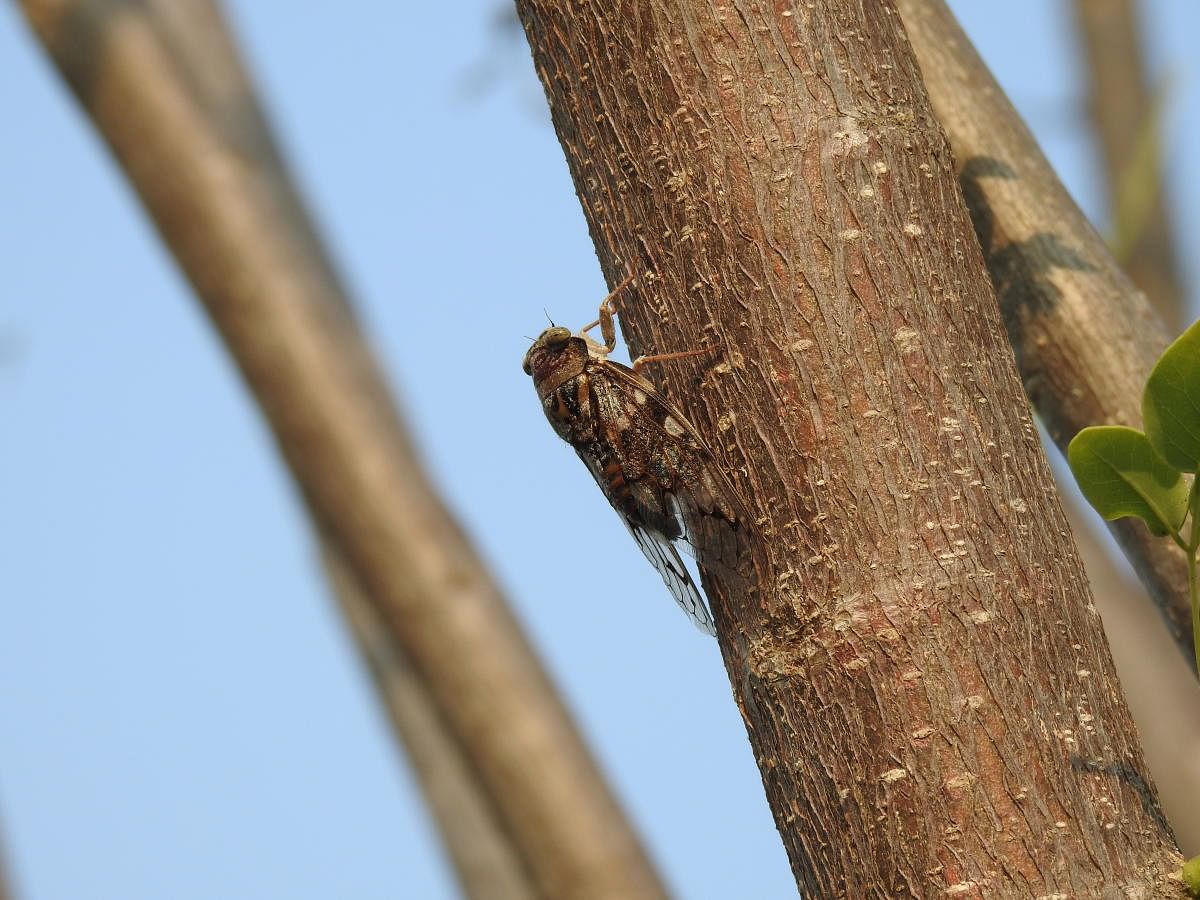
Over the last four years, Navilu Kaadu has roused our senses to nature’s rhythm. We are learning to recognise the sights, sounds and certain special visitors that herald each season. One such visitor marks the onset of summer.
Early this April on a blistering summer’s afternoon, while I was chatting with Chinnamma and Subbaiah, a loud, high-pitched chirping interrupted us. I recognised the ear-splitting racket from the previous summer — the song (shriek?) of the cicada. I followed the commotion to a young teak tree.
Scanning the bole of the teak tree, I spotted the stocky harbinger of summer right away. The fellow was causing quite a din, proclaiming how desirable he was to all the girl cicadas in the vicinity. Contrary to human clichés, the males are the source of hubbub in the cicada world while the females make nary a sound!
Same time last year, I had sighted swarms of trilling cicadas on the thorny acacia trees. I set out to inspect the three acacias along the pathway running down the middle of Navilu Kaadu. Sure enough, the trees thrummed with the plangent hum of a throng of cicadas.
Every summer as the mercury soars, mature nymphs (the young of the cicadas) dig their way out of the earth after spending an entire year in the subterranean world. The nymphs climb up trees, shed their exoskeletons and emerge as adults with protruding eyes and transparent wings, ready to mate. The male cicadas commence their legendary serenading to draw females and outshriek rival males.
How do they pull this off without vocal cords?
Cicadas are virtually live musical instruments with anatomies designed to make and amplify psychedelic music. The males vibrate ridged membranes called ‘tymbals’ on either side of the abdomen to produce strident high-frequency clicks. Their hollow abdomens, much like the hollow resonating body of the Indian veena or guitar, augment the sound from the vibrating tymbals.
If the serenading is any good, the lady conveys her approval with a flick of her wingtips and the pair mate. Soon the female lays up to 400 fertilised rice grain-like eggs in slits she carves on slender branches with her ovipositor (pointy egg-laying apparatus).
The young hatch after six to seven weeks and feed on tree sap. They resemble tiny termites. The cicada hatchlings drift to the ground and burrow into the soil, build a chamber and begin to develop, feeding on juices from plant and tree roots until they are ready to emerge the following summer and live out their short adult lives.
Most Indian species are annual cicadas, and the mature nymphs emerge once a year, while the periodical cicadas in North America emerge once every 17 years.
Underground nymphs
Cicadas spend their entire lives as nymphs underground, but for the two-to-four-week adult phase, when they emerge from the earth to procreate and perish. It is this spectacular cycle of appearing and vanishing from and into the depths of the earth that has fascinated human civilisations across millennia and transformed the humble cicada into a powerful symbol of resurrection, rebirth and immortality, especially among the ancient Greek and Chinese.
When female cicadas slit twigs to lay eggs, they help prune weak branches. The cicadas’ burrowing action aerates the soil, and they infuse a burst of energy when they emerge, serving themselves up in a delectable feast for birds, rodents and reptiles. In death, the cicadas return their nutrient-rich carcasses to the soil, offering a valuable source of nitrogen for plants and trees that once fed and nourished them, and life comes full circle.
Nothing ever goes waste in nature unlike in the fickle human world where nothing stays in use for long before entering the waste stream, sullying the earth, rivers, lakes and oceans for eternity. Of what use are we humans in life or in death?
Rooting For Nature is a monthly column on an off-kilter urban family’s tryst with nature on a natural farm.
The author chipped away at a software marketing career before shifting gears to natural farming. She posts as @ramyacoushik on Instagram. Reach her at bluejaydiaries@gmail.com.